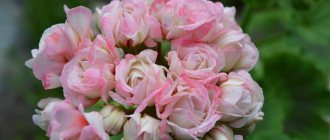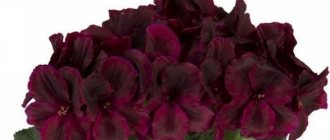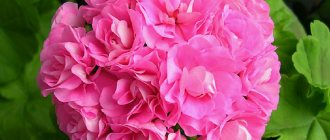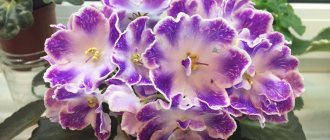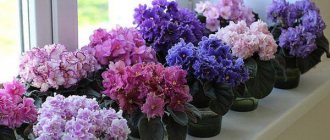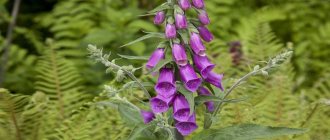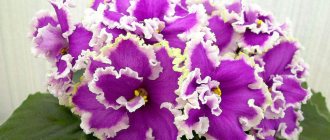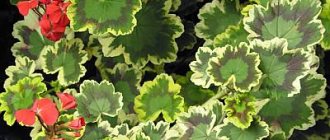Main types
This indoor plant is easily recognized by the original color of the leaves.
The leaf blade of this geranium has a green tint with a brown border. A group of indoor flowers called zonal geraniums belong to the so-called “grandmother flowers”. It is very widespread and includes thousands of varieties, among which there are those that you may have long been accustomed to seeing on your window or in a friend’s house. The zonal category of pelargoniums includes not only shrubs with edged leaves. Separation is also carried out according to flowers (plants with simple, semi-double or double inflorescences are distinguished). You can safely buy these types of home pelargonium for your home, even if you have not yet grown this flower. There are no difficulties in care, and the flowering of this group of plants is quite long.
Rosaceae
If you are interested in truly enchanting varieties of pelargonium, you should pay attention to rosaceae. This group got its name from the key features of the inflorescences
Their petals, and indeed the shape of the flower, are very reminiscent of garden roses.
If you compare a flower called rose geranium with a miniature English rose, it will not be so easy to find the differences, their buds are so similar to each other. Interestingly, this category of plants was actively grown in Great Britain back in the 19th century. However, in Russia, rose-flowered geranium has not yet become widespread.
Tulip-shaped
What is remarkable about this variety of homemade geranium? It has very beautiful buds, similar in appearance to tulips. A key feature of the plant is the fact that during the flowering period the buds do not open completely. Growing such geraniums at home is not too difficult. It is noteworthy that this beautiful hybrid was obtained as a result of spontaneous crossing. However, modern varieties of the plant are replenished with new specimens from this category.
Geranium varieties belonging to this category are distinguished primarily by their beautiful flowers with veins and patterns.
The leaves of such a plant are also worth paying attention to, since they are decorative. The leaf blade of pelargonium also has a characteristic aroma, which may differ depending on the variety.
Fragrant geranium is more successful in this regard, but fragrant leaves are one of the key characteristics of such pelargonium.
Ivy-leaved
Ivy-leaved geranium or pelargonium is a lush and branched plant that produces many flowing shoots.
That is why if you want to decorate your gazebo or porch at home beautifully, feel free to purchase a flower pot and plant such flowers in this container. Geranium buds have bright colors, and the leaves are smooth and have a slight glossy sheen. That is why the variety was called ivy-leaved.
Dwarf
A home greenhouse must certainly include hybrid pelargoniums. Opt for dwarf specimens, and the plant will not need to be pruned at all. Indoor perennial geranium blooms profusely, although the bush itself is miniature. If you are looking for herbaceous plants for outdoor use, dwarf geraniums are not the best option. This floral specimen will look much better on the windowsill next to other house plants.
Royal
The description of royal geranium is also recommended for every gardener to consider. This category of plants has gained wide popularity because they are difficult to miss. Their main advantage is considered to be bright buds of a wide variety of colors: white, pink, red, burgundy, etc. Moreover, the shape of the petals is usually terry or at least wavy. In addition, the shade of the buds is not monochromatic - closer to the core of the flower, the color also includes dark spots.
Pink fragrant geranium is considered an aromatic herbal plant. This flower specimen contains special substances - phytoncides, which are responsible for the production of the characteristic aroma. The smell is especially noticeable if you touch the plant. It is not difficult to care for it - the main thing is to pinch it from time to time. The flower loves this procedure, since there are more shoots on it, and in general a lush shrub is formed.
'Sutarves Clara San'
'Sutarves Clara San'
Post by NataK » Jul 10, 2013, 9:59 pm
Pelargonium 'Sutarves Klara San' (Sutarve) Zonal, rosaceous pelargonium. In my opinion, it must be a strong growing plant.
This is the first flowering, there are 11 flowers in the cap.
Grows on a south window. Pot - 10.
I really like the shape of the flower. Flower size - 3 cm.
We're not the only ones who love flowers:
Re: Clara San (Sutarve)
Post by Passific » Jul 10, 2013, 11:33 pm
Natalya, thank you for introducing me to this variety.
In shape and color, Klara San and Apple Blossom Rosebud are very similar. It will be very cool if Klara San is more discreet and compact, unlike Apple
Post by Mila M » Jul 24, 2014, 4:56 pm
The variety is very beautiful!
Post by midas » 07 Sep 2014, 00:37
Post by MAK » 07 Sep 2014, 00:52
midas, and I have this variety that is much more compact than Apple Blossom Rosebud. True, their age and volume are different. This is how she grew up, her blossoms were paler, but there was less sun for her. Age - less than a year. And Apple Blossom Rosebud grew 2 liters and was 2 times healthier. Age 4 years. One hat is fresh, the second is already withered. Volume 1 liter.
Post by midas » 07 Sep 2014, 01:21
Growing Denise pelargonium at home
Pink varieties of pelargonium
All representatives of the Geranium family of the genus Pelargonium have a reputation among experienced gardeners as undemanding plants that can be grown without much difficulty. But novice florists should know that these plants also need certain care and certain conditions for normal development.
Blooming in the warm season, similar to each other Denize Sutarve (left), on the opposite side - Fischers Appleblossom
Illumination and temperature conditions
During the period of active development, geraniums require an air temperature in the range of 20−27°C. Plants will not be damaged even at 30°C, but only if the air humidity near the bushes is above 70%. To do this, leave containers of water open next to the flower pots or regularly spray the bushes with a fine spray.
In order for the leaves and flowers of Pelargonium to be a rich shade, the bushes should be located on the side of the building where the sun will be most of the day. It should be borne in mind that scorching rays can burn the leaf plates, so pelargoniums are covered with protective, ultraviolet-scattering nets at noon.
During hibernation, unlike the warm months, flowers do not need a lot of sun and heat. During this phase of development, pelargoniums can remain indoors where the air temperature does not drop below +10-12°C.
Denise Sutarve inflorescences
Watering rules and humidity
During the growing season, the generation of flower buds, and then flowering, Pelargonium bushes need water to fill the cells of the flower petals and leaves. But excess water can have a negative effect on the plant. Pelargoniums may not be able to cope with excess moisture if frequent heavy watering is done not in the heat, when the evaporation of moisture from the surface of the leaves occurs at an accelerated pace, but in cool, cloudy weather.
You can determine whether a plant needs watering by looking at the condition of the soil. The wet surface of the soil substrate is a signal that the flower does not need water yet.
Fertilizing and soil quality
To transplant geraniums at home, use a ready-made substrate with a normal acidity level or independently prepare a mixture of turf/leaf soil, sand and high-moor peat (ratio 2:1:1).
Before placing any type of soil in a flower pot, it is disinfected and spilled with a solution of Fitosporin M to populate the soil with bacteria beneficial to the plant.
Flowers need fertilizing in the warm season - every 2 weeks; during winter dormancy, plants are not fed. In the spring on the eve of the growing season, nitrogen, phosphorus and potassium are added to the fertilizing composition, then complex fertilizers with a full set of microelements, but with a minimum amount of nitrogen, are used.
Flower container size
Some flower growers claim that for geraniums to set buds and flower, it is necessary that their roots completely fill the entire volume of the pot. But these pelargonium lovers forget that in the warm season, a flower transplanted into a flowerbed, where its root system grows in all directions and cannot be limited by anything, blooms much more luxuriously than in an apartment.
Therefore, we can safely say that in a spacious pot with drainage holes, with proper care, timely watering and fertilizing, an adult geranium will grow better than in cramped conditions.
Geraniums will bloom even in non-special flower pots
Pruning and replanting
The condition of pelargonium bushes is monitored throughout the warm period of the year. If you do not plan to get seeds from the flowers, cut off all faded flower stalks after flowering. Remove dried leaves regularly.
In the fall, before entering the dormant period, diseased branches are cut off from plants, bushes are thinned out, and stems are shortened. In spring, the plants can be transplanted into a new pot.
If the transplant is accompanied by division of the rhizome, choose small pots so that the flowers fill the flower bed with their roots as quickly as possible and begin to grow vegetative organs. Adult pelargoniums are transplanted into pots with a diameter larger than their crown. During replanting, try not to damage the roots of the flower and not completely remove the soil from the roots.
Agrotechnics of cultivation
Pelargonium Fischer appleblossom rosebud most often begins to bloom in the summer. In winter, it is recommended to maintain the temperature in the room where the bush is located at least 17 °C. Geraniums are placed on the sunny side. There should be no drafts.
Fischer pelargonium is propagated by cuttings, each of which should have 5 leaves. The seedlings are cut off and left in a room where fresh air penetrates. The shoots are trimmed to a size of 10 cm and then placed in a pot, covering the plants with plastic bags. After the roots appear, the bushes are watered and fertilized with superphosphate. The temperature in the room with geraniums should be maintained at 20-22 °C. Otherwise, the seedlings will not germinate.
Caring for a hybrid involves timely watering and fertilizing. After flowering, geraniums are pruned in the fall. The plant is transplanted from one place to another in mid-February.
Important! It is forbidden to leave the flower in shaded places. This leads to his death
Indoor geraniums are attacked by some garden pests. To eliminate this danger, it is recommended to water the plant with a preparation that kills insects. To prevent the plant from getting sick, before flowering it must be treated with an agent that prevents the development of fungal infections.
Growing
Varieties of rosebud pelargoniums
Terry balsam: characteristics, varieties and care
From the many rosebuds it is difficult to choose the most beautiful ones. Let's list a few of the most popular varieties, popular and pleasing with luxurious touching:
• Appleblossom rosebud is a magnificent variety of rosaceous pelargonium, distinguished by bright white flowers with a lilac-pink border and a green core, collected in a tight, large inflorescence.
• Denise is an absolute favorite of many exhibitions and a favorite of flower growers. A variety with huge, densely double flowers of a soft peach color, with a pink border along the edge of the petals.
• Albina is a compact crop with large snow-white double flowers with a slightly greenish tint to the petals.
• Pelargonium rosebud variety Beverly Park is a beautiful variegated bush with double salmon-pink flowers.
• Natalie is an exquisite variety with semi-double salmon-colored flowers with a wide white border on the petals.
It is impossible to convey the elegance of such a culture as Pelargonium rosebud. Photos showing rosebuds fully convey the beauty of the plant, but a living flower decorating a house or garden is truly a fabulous sight.
Home care
Description and characteristics of pomponella roses, planting and care
Pelargonium is considered an unpretentious plant. It grows quickly and reproduces well. But in order to achieve abundant and long flowering, it is necessary to provide it with suitable growing conditions.
Location and lighting
The flower is very light-loving. It requires direct sun for normal development. It is better to place it on south windows. But some species are more picky and prefer places with diffused light, protected from direct rays. If the sun is too bright, the flower may overheat. Therefore, it needs to be provided with good ventilation and shade from the midday sun.
The crop can also grow from the north side, but it is important that the daylight hours be long. If a plant experiences a lack of lighting, its shoots begin to stretch out and flowering weakens.
In summer, the flowerpot can be taken outside or onto the balcony. In order for the bush to grow evenly, it needs to be rotated around its axis from time to time.
Soil and drainage
Fertile, loose soil is suitable for pelargonium. You can buy a ready-made universal mixture or prepare it yourself from:
- turf land;
- peat;
- sand;
- humus.
The flower does not tolerate stagnant water, so the bottom of the planting container must be lined with a thick layer of expanded clay or pebbles drainage.
Planting and transplanting
Pelargonium practically does not require transplants. The procedure is carried out only if the roots become too crowded in the pot or the plant becomes sick. Take the container a couple of centimeters larger than the previous one. A pot that is too spacious is not needed to prevent the soil from turning sour. It is advisable to soak the clay container in water for a couple of hours before use so that it is saturated with moisture.
Lay a drainage layer. Sprinkle it with a little fresh soil. Carefully remove the pelargonium from the old pot without damaging the roots. You can only remove a little soil from above. Place the plant along with the earthen ball in a new container, add fresh soil and water it.
Visual video - instructions for transplanting Pelargonium using the transshipment method:
Temperature
In the spring and summer, indoor pelargonium needs a temperature of +20..25 degrees. If the flowerpot is placed on a balcony or terrace, then be sure to protect it from drafts and wind. In winter, it is advisable to move the flower to a cooler room with a temperature of about +12..14 degrees. But there are varieties that prefer warmer wintering. The main thing during this period is to ensure good air circulation to the plant.
Air humidity
Pelargonium is unpretentious to humidity
It can develop normally at low humidity in city apartments. Please note! Spraying the plant to increase humidity should not be carried out, since this may affect the appearance of the pubescent leaves. If the room is too hot, you can spray the surrounding air or place a container of water next to the flower.
Feeding and fertilizers
For long and lush flowering during the growing season, you need to provide pelargonium with regular feeding 2 times a month. Some gardeners recommend dividing the required fertilizer rate into several parts and applying them during each watering of the flower. Universal formulations for flowering crops are suitable for this.
After transplantation, fertilizer can be applied only after a month. Before flowering begins, it is recommended to apply fertilizers containing potassium and phosphorus. It is not recommended to introduce organic matter; pelargonium does not absorb it well. It is better to refuse it. In winter, the flower rests and does not need feeding.
Watering
In summer, water the shrub after the substrate has dried a couple of centimeters deep. Take water at room temperature, well settled. In winter, the amount of watering is reduced. If, during a cool winter, water stagnates in the soil, this will lead to the appearance of root rot and the death of the crop. But the earthen clod cannot be allowed to dry out completely.
Trimming
Bush varieties of the crop require pinching for greater bushiness and stimulation of flowering. The shoots are pruned in the fall after flowering has completed. A sharp, thin knife is used for the procedure. The cuts are made at an acute angle above the leaf node. Treat the cut areas with wood ash.
It is also necessary to remove all dry stems and flowers, weak and elongated shoots. Don't be afraid of major pruning. In the spring, pelargonium, with proper care, will quickly produce young shoots. Spring pruning is needed only in case of strong growth of the bush and uneven formation of the crown.
Landing
Let's find out the requirements of this plant for its habitat, soil, and lighting.
Location and lighting
In order for Pelargonium Clara to delight you with its flowering for a long time, you need to place its pot in a bright place. Like all geraniums, this plant does not like shade. If Clara does not have enough light, decorative flowering will not work: there will be few inflorescences, and those that appear will not be large in size.
Attention. With a lack of lighting, the color of the foliage noticeably fades, which also negatively affects the appearance of the flower.
Direct sunlight is dangerous for this plant, so at midday in summer it is recommended to shade the pot with translucent paper or cloth. In winter, it is necessary to organize additional lighting for the plant in the form of an artificial light lamp.
If this measure is not taken into account, the flowering period will decrease, and the buds themselves will become much less lush and decorative. In addition, with a lack of light, Clara’s stems stretch and the foliage turns pale. This also negatively affects the beauty of the plant.
The soil
As for the composition of the soil, in this regard Pelargonium Clara is not particularly demanding. Much more important for the plant is good drainage.
Don't forget to put a layer of expanded clay on the bottom of the pot. Geranium does not tolerate waterlogged soil.
Its delicate roots can easily rot in such conditions. Pelargonium Clara Sun will feel best in soil with either a neutral or slightly acidic reaction.
Experienced gardeners add ash to the soil if it is too acidic. Recommended substrate composition:
- leaf soil - 1 part;
- turf - 1 part;
- peat - 1 part;
- sand - 1 part.
If the soil is not very nutritious, you can also add humus. You can buy a ready-made substrate for geraniums in the store - in this case it will be optimal.
Watering
Regular soil moisture is very important for Clara pelargonium. Although watering should be quite abundant, it is also important to prevent waterlogging of the soil.
Otherwise, the roots of the plant may begin to rot. Therefore, water only when the top layer of the substrate dries.
Advice. In summer, the plant is watered daily, and in winter, once every three days is enough. It is also recommended to loosen the top layer of the substrate after watering to ensure good soil aeration. Pelargonium Clara does not need spraying.
If there is a need to humidify the air, then this must be done using a spray bottle, directing the stream to the area around the pot, and not to the plant itself.
Feeding
The plant needs additional nutrition. Clara responds to proper application of the necessary fertilizers with longer and more luxuriant flowering.
In spring, the plant needs nitrogen compounds, and when the inflorescences begin to form, it is better to focus on potassium-phosphorus complexes. In the store you can purchase a complex mineral composition for pelargoniums. It will fit optimally in this case.
It is important to know that pelargonium does not like organic fertilizing. It is also important not to exceed the dose of fertilizer specified in the instructions.
If you overuse fertilizing, the roots of pelargonium may well get a chemical burn. The frequency of fertilizing during the growing season is twice a month; in winter, the plant does not need additional nutrition.
Trimming
Only competent and timely pruning can give the pelargonium bush the correct compact shape and protect the plant from elongated, ugly shoots. Let us note that it was the inability to properly trim a flower that at one time was the reason for the loss of popularity among pelargoniums among flower growers. To form a compact and lush bush, you need to regularly pinch the apical parts of young shoots. This measure will allow the plant to grow wider and form a larger number of flower stalks.
As a rule, shoots of young plants are pinched after four to five pairs of leaves appear on them. The most suitable time for pruning is the spring months. And if pinching is used for young shoots, then pruning is used for adult plants.
Attention. To make the cut smooth and least traumatic for the bush, you should use a clean and very sharp knife
And after the procedure, you must sprinkle the cut areas with coal, wood ash, or lubricate them with brilliant green.
The plant requires special attention in the first year of its life. During this period, it is necessary to spend the maximum amount of effort to form the correct shape of the bush. But in the second and subsequent years you can relax: the formed bush will require only “cosmetic” pruning.
Care
Among the basic rules of care, the following should be highlighted:
- Watering. Plants need moisture, but with too much moisture they begin to rot and get sick. Therefore, it is worth organizing a watering system and sticking to it. It is better to water the plant in the first half of the day. In summer, do this once every couple of days, and in winter, when the first layers of soil dry out.
- Fertilizer. Fertilizer for flowers must be applied in the evening to moist soil. In the summer you can fertilize once a week, and in the autumn-winter periods once every three to four weeks. In winter, the plant needs nitrogen supplements, and in summer, potassium and phosphorus.
- Transfer. If necessary, geraniums must be replanted. If it no longer fits in its previous pot, then you need to choose a container that is only one and a half to two centimeters larger than the previous one. The plant needs to be replanted when it begins to emerge from hibernation, which means in early spring.
- Trimming. New shoots must be pruned to allow the plant to continue to grow. All dried leaves and shoots also need to be removed.
Key Features
Pelargonium "Angel" is a bush about 30 cm high, but there are also representatives up to 60 cm in height. Woody and narrow stems are covered with many leaves and form a green cap. Some species have tiny fluffy hairs on the surface that emit a fresh scent. The buds are elongated, with sharp tips, and collected in inflorescences. They are so similar during flowering to violets and pansies that they are sometimes sold in stores under the name “Violet flowers.”
Among other pelargoniums, “Angel” stands out due to the difference in the color of the upper and lower petals. There are usually five of them: two upper and three lower, the lower ones are not so large and are arranged like a fan. There are variations with pink, lilac, white, scarlet, purple, burgundy shades. Often the flowers are bicolor (painted in two colors): pink/burgundy, lilac/purple, white/fuchsia. There are tricolor colors, for example, "Debbie", combining burgundy, pink and white tones.
Despite the fantastic combinations of colors, one should not expect from the variety the richness of the color palette of the royal geranium, with which it is often confused
Another important difference is the smaller leaves and inflorescences. Hybrids are found in home gardens on the windowsill
Selection of planting material
Modern flower shops offer for sale a variety of varieties of double pelargoniums, plants with simple inflorescences, among which it is worth selecting the most suitable planting material. To avoid mistakes, it is advisable to study information about the species of interest in advance. Below are descriptions of several varieties and cultural hybrids that invariably receive favorable reviews from flower growers.
Pelargonium Crystal Queen f1
The wonderful pelargonium Crystal Queen f1 is a powerful plant that can easily be grown from seeds. Bushes of this hybrid in the amount of 1 - 2 pieces can be planted in a large hanging basket.
Unpretentious ampelous pelargonium Crystal Queen f1 red is characterized by the presence of hard leaves, strong shoots up to 30 cm long. It withstands precipitation and wind. About a hundred beautiful flowers can bloom simultaneously on one plant. The culture is recommended for growing in hanging pots, balcony boxes, and mixed containers.
Pelargonium Tornado f1
The magnificent pelargonium Tornado f1 was bred by Dutch breeders. European gardeners speak extremely positively about the plant. This red pelargonium with shoots 30 cm long looks great in hanging baskets and is often used for landscaping. The flowering of a crop that does not require the use of growth stimulants will certainly be long and abundant.
Pelargonium Tuscany
The popular Tuscany pelargonium has many varietal forms. They all look extremely attractive. The ampelous pelargonium Toscana Eva is in particular demand, delighting florists with large white flowers that bloom on hanging shoots about 50 cm long. The flowering of the crop starts in May and continues until frost.
Reproduction
Although they say that the propagation of rosebud pelargoniums is a very protracted and complex process, often leading to failures, if a number of certain requirements are met, everything will work out. Next, we will consider in detail the main points on the propagation of April Snow: we will consider only the method of cuttings, because rosebud pelargoniums reproduce at home in this way.
- The cutting must be cut from a large, healthy mother plant. The more powerful and stocky the cuttings you cut, the stronger and more well-flowering plant you will end up with.
- The length of the cut apical shoot should be about six to seven centimeters. The lower leaves and inflorescences must be carefully removed to prevent them from rotting underground.
- The cut is dried a little in the air, after which the cutting is rooted immediately in the ground. Water rooting is not very suitable in this case, since in rosebuds the cuttings in water often rot before the roots emerge.
- The container with the cutting must be placed in a well-lit and warm place - a south-facing window sill will do. After about 2-4 weeks, the shoot takes root. When the plant gets a little stronger and takes root well, it is transplanted into a real pot.
Pelargonium has many interesting varieties, for example, PAK Salmon, Yug, Angel, Prince Gustav, Zvezdchataya, Stellar, Denise, Clara Sun, Norland, Rococo.
How does it reproduce
There are two methods of propagation - seed and cuttings.
Seeds are sown in January in nutrient soil. It is important that the temperature does not drop below +23 degrees. After two leaves appear on the seedlings, picking is carried out.
The most popular propagation option is cuttings. The top shoots about 8 cm long with 2-3 leaves are cut from the mother bush. The cutting is placed with the lower cut into a growth stimulator, then placed in nutrient soil for rooting.
Further care
Sutarve Clara Sun is unpretentious, but it is still necessary to follow the basic rules for caring for flowers so that they please gardeners with their appearance and long flowering.
To prevent the plant from stretching out, it is provided with an optimal light regime and shaded. To form a crown, a beautiful, even shape of the bush, periodically turn the pot. This way the branches and leaves are stretched evenly.
Water, observing the temperature regime. Feed and prune in a timely manner. If you follow the rules of care, Sutarve Clara San will constantly bloom and have a well-groomed appearance.
Temperature
Flowers should grow in a warm place. Comfortable temperature is from +14 to +27 °C in summer. This variety of pelargonium loves fresh air (not drafts), so the room is periodically ventilated. If the air in the apartment is dry, the tips of the leaves of the bushes dry out.
The plant does not tolerate temperatures below +12 °C - its growth and development slows down. Later it dies from hypothermia.
Watering and spraying
Pelargonium Sutarve Clara Sun is properly watered and sprayed if necessary. The plant does not tolerate either drying out or excessive moisture. Watering is carried out as the top layer of soil in the pot dries. If the earthen ball is constantly wet, then the roots of the flower begin to rot. In time he will die. Pelargoniums Sutarve Clara San can accumulate moisture and go without water for some time. Watering frequency is once every 1-3 days, less often in winter.
To prevent the leaves of the bush from drying out, spray them with a spray bottle with a fine spray nozzle. During the procedure, make sure that excess water does not collect in the rosettes of leaves - this harms the plant. In winter, spraying is not required. Sutarve Clara San, under optimal external conditions, does not require abundant watering and spraying.
Loosening
Sutarve Clara San grows normally in aerated soil, so it is periodically loosened in pots. If you do this after every watering, it will save you from fungal diseases.
Loosening is carried out carefully, penetrating the tool shallowly, without damaging the root system of Pelargonium Sutarve Clara San
Feeding
For abundant flowering, fertilizing is carried out regularly. Do not fertilize bushes only in winter, when they rest. For feeding, ready-made liquid fertilizers and universal compositions for flowers are used. It is better not to saturate Sutarve Clara Sun with organic fertilizers.
| Month | What to do |
| January | No fertilizing is carried out, the plant is resting |
| February | |
| March | Fertilize with fertilizer with a high phosphorus content |
| April | |
| May | Apply fertilizers with a high potassium content |
| June | |
| July | |
| August | |
| September | |
| October | |
| September | Fertilize with fertilizer with a high phosphorus content |
| December | No fertilizing is carried out, the plant is resting |
For continuous year-round flowering of indoor Sutarve Clara San, they are fed with magnesium sulfate. After applying fertilizer, the plant intensively grows buds and constantly blooms. Magnesium sulfate is stirred at the rate of 5 g per 5 liters of warm water. Water carefully, under the root.
Trimming
Constant pruning stimulates crown growth. It is not advisable to do this with scissors, because this will damage the flower branches. Cut the shoot at an acute angle using a utility knife or blade. The cut area is sprinkled with a powdered activated carbon tablet. Pruning is carried out at the end of February.
The tops and excess young shoots are carefully pinched without damaging the stem.
Growing problems and pests
Main pests: whitefly, spider mites, aphids. Insects are removed manually or insecticides are used.
An unpretentious flower with increased decorativeness - this is the amazing pelargonium Sutarve Clara Sun
The most dangerous disease is root rot. The reason is excessive watering. It cannot be treated and the plant will have to be disposed of.
If the leaves on the plant begin to fall off, this is a signal that its soil is poor and requires feeding.
Such is the delicate pelargonium Sutarve Clara San, a beautiful plant that is ready to become a worthy decoration of any interior.
Description of pelargonium Sutarves Klara San (Sutarve Clara San) and care for it
A stunningly beautiful plant with soft pink lush flowers, pelargonium Sutarve Clara San, is often grown in summer cottages, in rockeries, next to alpine hills. An unpretentious plant to care for, it belongs to the group of zonal pelargoniums.
Description of the variety
Pelargonium Sutarves Klara San was selected in 2022. It has double flowers that are highly decorative; due to the small number of petals, the bud does not open completely.
Pelargonium Sutarve Clara San - an ideal plant for true romantics
Features of the variety:
- The inflorescences are shaped like roses. The petals are pink, the middle is light green. Diameter - 3 cm.
- The buds are collected in inflorescences.
- The leaves are large, rich green in color. Each rounded leaf rests on its own long stem.
- Flowering continues from March to early November.
- Fast growth rate, within a year the plant develops into an adult shrub.
Note! The more light there is in the place where pelargonium or geranium is planted, the brighter and more saturated the pink petals will be.
Similar varieties
Pelargonium Clara Sun is similar to some other decorative varieties related to geraniums.
Pelargonium Odensjo Symfonia - description
This is another zonal pelargonium. Anna Sun is a bush up to 35 cm high, but very neat. Terry soft peach flowers are collected in a decorative inflorescence.
A distinctive feature of the variety is double snow-white flowers with a light pinkish tint. Pelargonium flowers Sutarve Nadya K are up to 3 cm in diameter, collected in inflorescences.
The bush is compact and does not lose its shape even without constant shaping. The leaves are rich green.
This variety of pelargonium is distinguished by elegant speckled petals. Snow-white flowers are decorated with pink edging and specks. The leaves are elegant, bright green.
For reference! There is another similar variety, which by the way does not belong to the Sutarves variety. Such a flower is the Alpenbloss Fischer pelargonium.
Planting and transplanting
Pelargonium Tuscany and its varieties Edwards, Bernd and others
The plant is unpretentious, but it is important to provide it with normal care. For pelargonium to grow and bloom, it is necessary to create optimal conditions for the plant.
For pelargonium to grow and bloom, it is necessary to create optimal conditions for the plant.
Choosing a place and pot
The pelargonium variety Sutarves Klara Sun needs natural light, so place the plant on the south or southeast side.
However, in summer it is important to create openwork shading for the flower to protect it from direct rays of the sun. Suitable pot diameter - approximately 2 cm larger than the crown projection
If you choose a larger container, the plant will spend a lot of energy on developing the root system rather than growing and flowering.
A suitable pot diameter is approximately 2 cm larger than the projection of the crown. If you choose a larger container, the plant will spend a lot of energy on developing the root system, rather than growing and flowering.
Note! The pallor of pelargonium foliage will indicate a lack of light.
Soil selection
Almost any soil is suitable for Sutarve pelargonium, but a drainage layer of crushed brick and expanded clay is important. This is the prevention of waterlogging.
Slightly acidic or neutral soil is suitable. You can prepare the substrate yourself by mixing leaf soil, sand, humus and turf in equal proportions.
Step by step planting process
It looks like this:
The container is filled with drainage and substrate, then moistened. Seeds are placed on the ground at a distance of 4 cm from each other. Carefully deepen by 0.5 cm and sprinkle with earth. Gently moisten with a spray bottle. Wrap the container in plastic wrap to create a greenhouse effect.
After about 10 days, sprouts will appear. After this, the film is removed and the container is placed closer to the light source.
Further care
Pelargonium Dovepoint - description, planting and care
In order for the plant to delight with elegant flowering, it is important to provide it with good care. Pelargonium Clara Sun will be the pride of any gardener
Pelargonium Clara Sun will be the pride of any gardener
Temperature
The optimal temperature for this variety of pelargonium is from +18 to +24 degrees; it is in such conditions that one can expect growth and beautiful flowering.
Watering and spraying, humidity
Pelargonium is afraid of swampy soil, but it is also afraid of excessive dryness. Watering is carried out as the soil dries; it is recommended to spray with a spray bottle every day in the summer, early in the morning. And in autumn, winter and early spring - no more than once a week.
To maintain optimal humidity for the plant, spray the air next to it.
Description
Pelargonium Clara Sun is the brainchild of artificial, targeted selection . The plant has a beautiful appearance, is a wonderful decoration for the home, is able to harmonize the microclimate, and also has medicinal properties.
Reference . This plant appeared on sale only in 2016, having been bred a little earlier.
Along with its remarkable appearance, Clara pelargonium is also quite unpretentious. However, it needs high-quality pruning - otherwise it will not be possible to form a lush bush.
Diseases
Pelargoniums can be affected by pests and diseases, and have various problems associated with lack of care and maintenance. Next, we will look at the most common problems that arise when growing these beautiful plants.
Edema
Some gardeners notice the appearance of soft, watery pads on the leaves of plants. These defects occur due to waterlogging of the soil, and in order to eliminate the swelling, it is necessary to urgently reduce watering.
Leaves fall, stems become bare
Similar problems arise if the stellars are kept in an insufficiently bright place. To eliminate unsightly “flaws in appearance,” move the pot with the plant to the most well-lit windowsill in the house.
Gray rot
This disease is the most common one that occurs in this type of pelargonium. The pathology is caused by a fungus and occurs due to excessive waterlogging of the plant. Note that gray rot is contagious, so radical and urgent measures must be taken to save the plant.
It is necessary to remove and burn the diseased leaves, treat the entire plant and those next to it with a fungicide using a sprayer. In addition, a mandatory measure is to reduce watering and increase the frequency of ventilation.
Where and how to plant it?
Lighting and location
If a gardener wants his pet to please the eye with its flowering for a long period, it is necessary to place the pot with the plant in a well-lit place. The flower does not like shadow. A window sill with windows facing south or southeast is perfect. But, it should be remembered that on too hot days, when the scorching rays of the sun penetrate the atmosphere, pelargonium should be shaded.
This can be done using a piece of fabric or translucent paper. Decorative flowering cannot be achieved if there is not enough sunlight.
In winter, you need to take care of additional light. You can use a special lamp.
Soil requirements
The flower has no special requirements for soil. More important than the soil is the drainage layer. There must be a layer of expanded clay at the bottom of the pot. Pelargonium has a negative attitude towards waterlogging. The delicate root system can easily rot in such conditions. The optimal soil for Clara Sun is neutral or slightly acidic. It is recommended to add ash to acidic soil.
Substrate composition:
- 1 part leaf soil;
- 1 part sand;
- peat and turf also 1 part each.
If the soil is not particularly nutritious, humus is added to it. In flower shops you can purchase ready-made soil, which is designed specifically for pelargonium.

